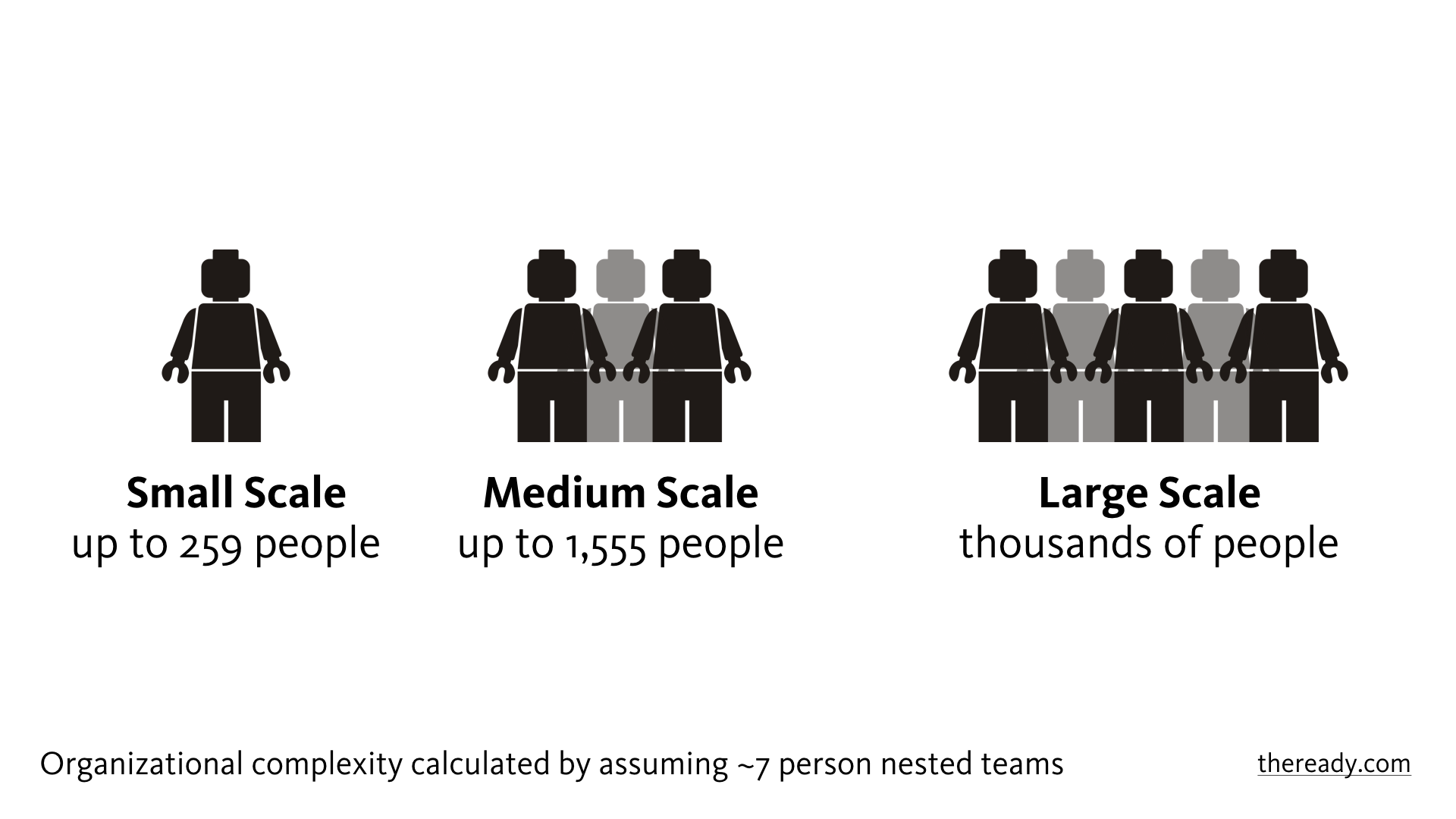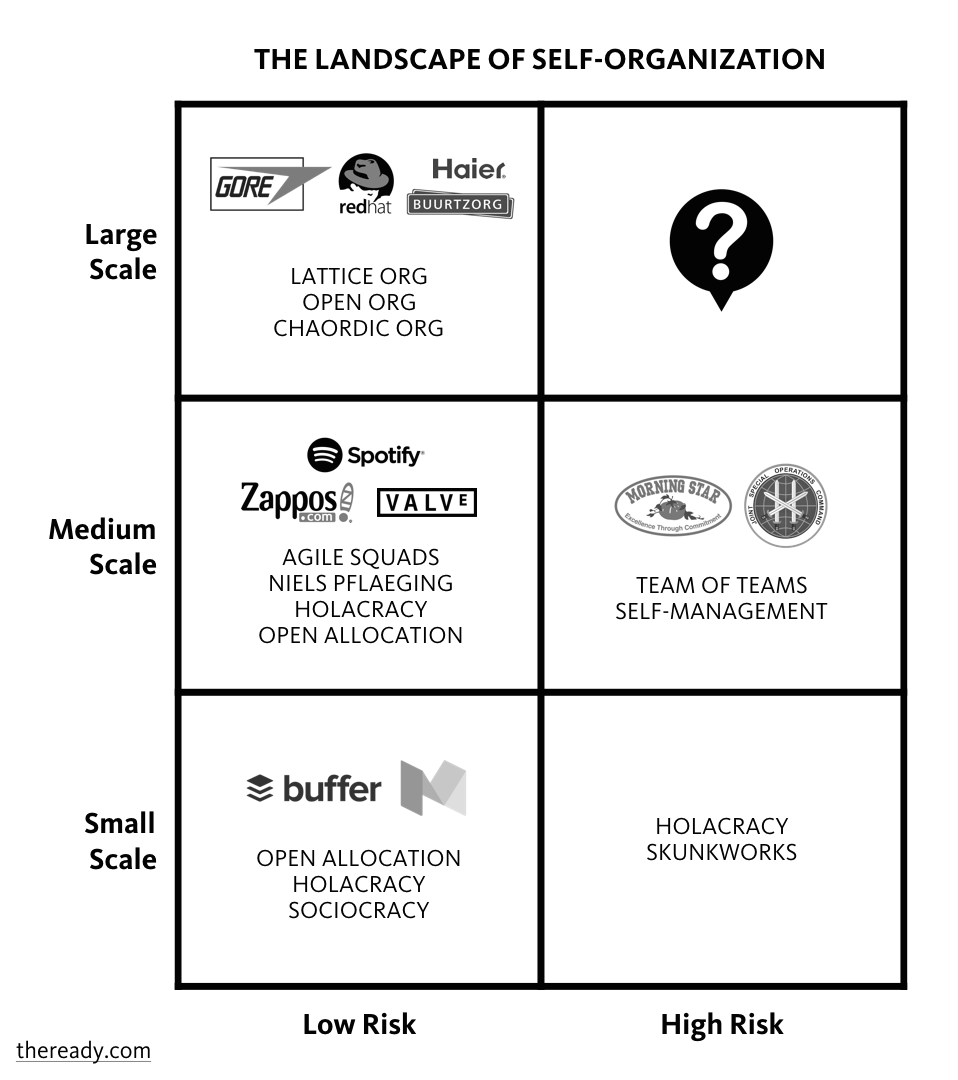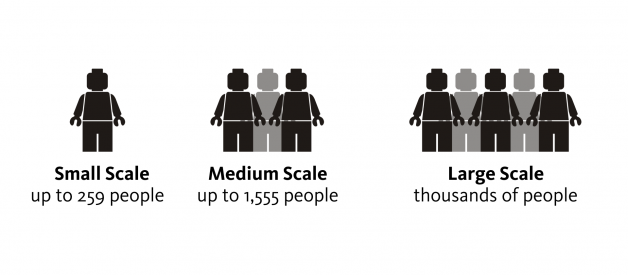
Everyone who has worked in a company that is command-and-control, bureaucratic, or hierarchical for more than a few years agrees: the way we?re working isn?t working. From military generals like Stanley McChrystal to reformed corporate heroes like Red Hat CEO Jim Whitehurst, the call for change is clear: our organizations need to be more open, fluid, adaptive, decentralized, and empowering.
The problem is, we don?t actually know how to do that in every context. We all feel the tension, but our situations vary wildly. And so as each new approach comes to the forefront, we rush to consider if it?s the panacea we?ve been waiting for, and in finding that it?s not, we dismiss it and keep waiting for the perfect operating system to land in our lap. The most common line of questioning I get? ?Who is doing self-organization in the B2B space? Who is doing it in the industrial space? Tell me someone just like us is doing this, so I know it?s safe.? This is easier said than done.
Over the past few years I?ve had the unique experience of implementing various forms of self-organization and self-management in dramatically different contexts, from a 25-person startup, to a non-profit, to a Fortune 10 conglomerate. Along the way I?ve learned that certain characteristics of the context heavily influence what kind of system will work and spread. In this piece, I?ve tried to summarize my hypothesis, as well as what I hope to see (and learn) next. I?ve consciously avoided talking about how these systems are rolled out, which is also critical to their overall success.
Different contexts = different operating systems.
While the reality is incredibly complex, there seem to be two characteristics that have the biggest impact which new form of self-organization will fit and spread. Scale (in terms of headcount) and Risk (in terms of exposure to serious consequences). Both are continuums ? but for this thought exercise, I?ve defined them clearly.

Scale matters because it typically correlates with complexity, and the more complex a system is, the harder it is to influence or change it without unexpected consequences (or outright rejection). Big systems have an inertia to them. It?s hard enough to give thousands of people a message and have them remember it? now try changing their mindset. This presents a training conundrum: by the time we teach 100,000 people a new way of working, the world may well be underwater from climate change, or the self-organizing startup down the street has put us out of business. So, as scale increases we need something that is more intuitive and spreadable, either through software, simplicity, or both.

Risk matters because it impacts our ability to try and fail. Self-organized and decentralized operating systems are optimized for learning and adaptability. Unfortunately, this comes at a cost. Mistakes will be made. Some things will work, some won?t. And without central governance to restrict behavior and create a culture of fear, the quality and judgment of your people (and any advice process they are subject to) will be the first and only line of defense. In the vast majority of contexts this is okay ? better even, but in some situations we may want a system that limits innovation as a tradeoff for safety and security. In a healthy organization this tradeoff is made by employees committed to the purpose, through a participatory process, and not ?management.?

By combining these two characteristics we get the chart above. In it, I?ve made an attempt at cataloging some of the most popular forms of self-organization, plotted against the scale and risk profile in which they work best, and calling out examples of brands in the space developing or using these approaches. This is early days to even consider such an exercise, so I offer the disclaimer that this is just the beginning and we will iterate on this framework in the months ahead based on your feedback.
Small Scale, Low Risk. This is the typical startup context. The possibilities are endless, and very little is known. The job of the team is to discover what works. Chaotic or truly self-organizing (meaning no method whatsoever) teams are commonplace. A very raw flavor of Open Allocation is also popular here, effectively turning the startup into a talent marketplace where everyone ?votes with their feet.? Startups like Valve and Github have thrived on the concept. And of course, Holacracy is making big waves in this context. It strikes a balance between chaos and control that appeals to many in this stage.
Small Scale, High Risk. Occasionally we do see startups with incredibly high stakes, in markets like healthcare and defense. The nature of their consequences changes their ability to absorb mistakes. While almost any approach can be modified to address this issue, it?s easiest to have extremely clear written governance and clarity of roles (as offered by Holacracy). I also include Skunkworks here as a wild card for your consideration, based on the fact that some highly sensitive innovation has occurred in small teams using that protocol.
Medium Scale, Low Risk. This context fits the startup or established business that has achieved product-market-fit and has settled into the groove of business operations and scaling. I also characterize smaller startups (<259 ppl) that are growing very quickly as medium scale, since their rapid headcount growth creates the same symptoms. To date, this context seems to be experiencing the most innovation in terms of ways and means to self-organize: Spotify?s Agile Squads being one of the more interesting. The work on organizing for complexity that Niels Pflaeging and BetaCodex have done is also right at home here. Holacracy is being tested at this scale, and the jury is still out on whether it can go further.
Medium Scale, High Risk. This context is a fantastic proving ground for new ways of working and organizing, because it is where some of the most important and critical work is happening. Not nearly as much experimentation is going on, but we are so thankful to have McChrystal?s work with the Joint Special Operations Command to reference here. His ?team of teams? framework is philosophically linked to so many other systems we?ve discussed, and it has worked in the context of combating terrorism (it doesn?t get more high stakes than that). Morningstar, while a lot less James Bond, does create food that is subject to regulation and the risk of food borne illness, and so their approach to self-management belongs here as well.
Large Scale, Low Risk. Here we find many of the originators and heroes of the self-organization and self-management movement. The hippies. The risk takers. Concepts like Lattice (now Open Allocation), Chaordic, and Open organization live here. Companies with more than 10,000 employees have rarely (to date) made the transition from command-and-control to a new way ? most of these examples made that shift at birth or medium scale. But that doesn?t mean we shouldn?t try. I believe that our biggest opportunity ? to change lives and create impact ? exists in this context. Just look at Buurtzorg, or RedHat, W.L. Gore, or even Haier and tell me you don?t wish the whole Fortune 500 acted that way. The world would be a better place.
Large Scale, High Risk. And finally we come to the black hole. In this context, you truly can?t afford certain kinds of mistakes, not to mention an interminable training program for a complex new way of working. I?m at a loss to reference anyone here, especially north of 10,000 employees, that is really doing it ? really empowering their entire workforce. We need innovation here, but we have to earn it. Every transformation, every success, every person trained is a chance to unlock this puzzle box.
Is this framework overly simplistic? Yes, it is. Do these approaches to self-organization overlap in theory and practice. Yes, they do. But with that said, I believe there is immense value in the analysis ? in asking, ?What works best? Where? Why?? If this post can spark a discussion, a series of corrections, some fresh examples, or help nudge a curious leader into action, it will have been worth it.
Ready to change how you work? The Ready helps complex organizations move faster, make better decisions, and master the art of dynamic teaming. Contact us to find out more. While you?re at it, sign up to get our newsletter This Week @ The Ready delivered to your inbox every week.
Follow me on Twitter | Follow The Ready on Twitter | TheReady.com


